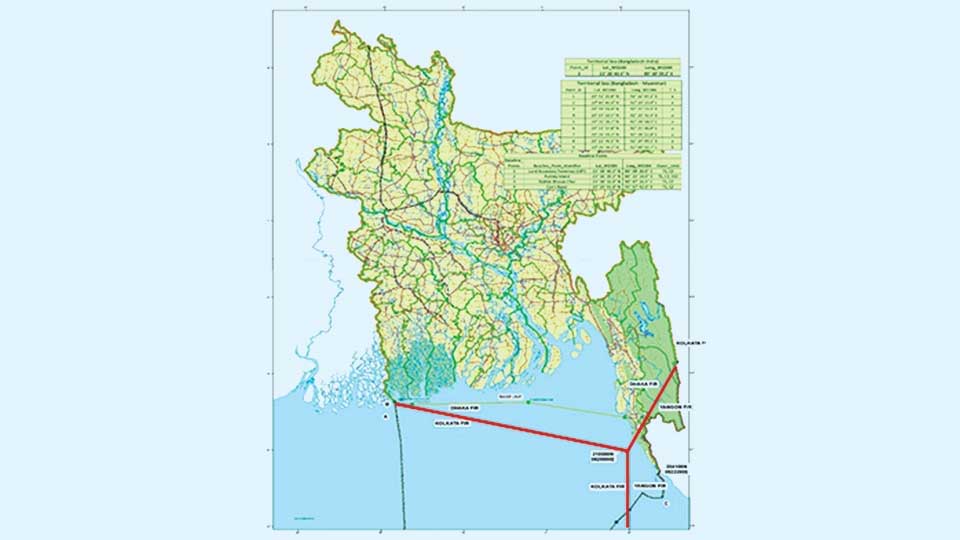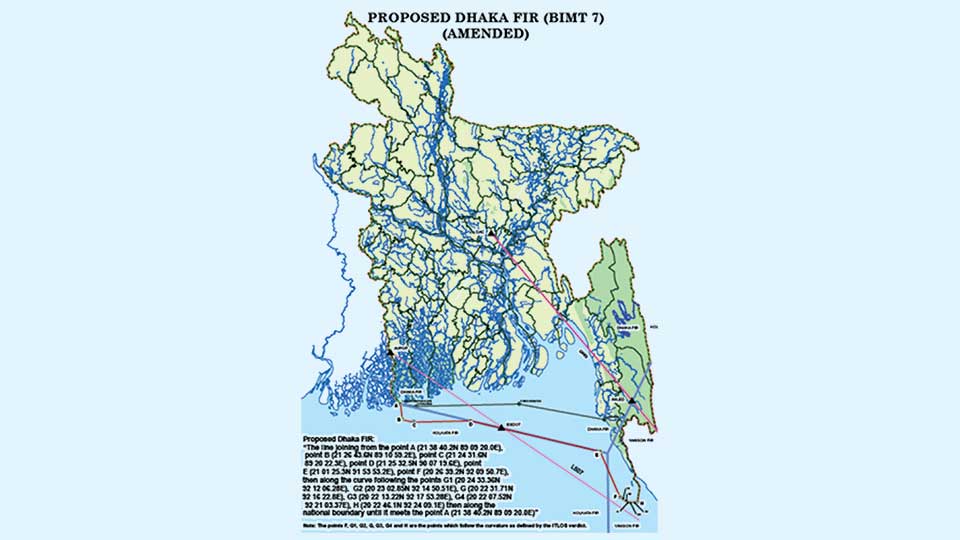Bangladesh eyes full control of its skies, expanding Dhaka FIR
Full airspace control could bring in BDT 500 crore yearly in overflight revenue
Full airspace control could bring in BDT 500 crore yearly in overflight revenue

Dhaka : Bangladesh is on the verge of a historic step toward strengthening its aviation capacity - taking full control of its skies. The government has moved ahead with a proposal to expand the country's Flight Information Region (FIR), a move that will not only reinforce national pride but also unlock significant economic and strategic potential.
It is estimated that roughly 70 flights pass through Bangladesh's FIR daily on the L-507 route alone, generating about USD 31,500 per day - or BDT 100 crore annually - in overflight revenue, though Bangladesh receives this revenue, but misses the pride to control the route. If Bangladesh gains control of all international air routes that cross its maritime zone, the country could earn at least BDT 500 crore per year, if not more. That is a significant amount of foreign currency for our economy.
The Civil Aviation Authority of Bangladesh (CAAB) has already forwarded a detailed proposal to the International Civil Aviation Organization (ICAO) to realign the Dhaka FIR so that it fully coincides with the nation's land and territorial boundaries. Once approved, Bangladesh will gain authority to manage all aircraft flying over its airspace.
This is not merely an aviation issue. It is about prestige and economic opportunity. Every sovereign nation should have full control of the airspace above its territory and maritime zone.
Inherited limitation
The Dhaka FIR, which Bangladesh inherited after independence, covers most of the country's airspace. However, certain corridors remain under foreign control.
A small section in the southwest - the L-507 route, which runs from Kolkata to Bangkok - is currently managed by Indian authorities, while parts of the airspace over Teknaf, Cox's Bazar, and St Martin's Island fall beyond Dhaka FIR.
This means that, technically, we require permission from another country to fly over certain parts of our own land. That is not just inconvenient - it undermines our national dignity.
Economic stakes high
The financial implications of FIR control are substantial. Every aircraft flying through a country's FIR pays a fee for air navigation and traffic management services, typically ranging between USD 400 and USD 600 per flight. These charges can add up to millions of dollars annually.
Beyond revenue, full FIR control would also enhance aviation safety, monitoring capability, and help reach the future goal of attaining strategic awareness over the country's Exclusive Economic Zone (EEZ) - an area of immense geopolitical and economic value.
From sea to sky : building on maritime success
Bangladesh's quest for greater airspace control follows its successful resolution of maritime boundary disputes with both India and Myanmar in 2012 and 2014. Those verdicts established Bang-ladesh's EEZ, paving the way for economic activities under the Blue Economy framework.
Just as we have claimed our rights over the sea, we must now claim our rights over the sky. The airspace above our EEZ is just as much our part as the waters below.
Currently, international routes over Bangla-desh's maritime zone are managed jointly by India and Myanmar. Realigning the FIR boundary would allow Bangladesh to manage those routes directly- and collect the associated navigation fees.
Diplomatic, technical progress
Revising an FIR boundary is a complex and time-consuming process, typically requiring five years or more and the consent of all neighboring countries.
Bangladesh first submitted its proposal to ICAO's regional office in Bangkok in 2019. The Ministry of Foreign Affairs (MOFA) followed up with diplomatic communications to India and Myanmar. By 2021, India had issued a "no objection" note, and in January 2024, Myanmar also responded positively - major milestones toward final approval.
The diplomatic groundwork has been laid. Now it is about following through with ICAO and demonstrating that Bangladesh has the capacity to manage this expanded airspace safely and efficiently.
Upgrading nation's air traffic capabilities
Bangladesh's ability to manage a larger FIR depends on technology, training, and institutional capacity. To that end, the government has installed a state-of-the-art Air Traffic Management (ATM) system at Hazrat Shahjalal International Airport (HSIA), supplied by French aerospace company Thales under a government-to-government agreement.

Map of proposed new Dhaka FIR boundary
The system provides advanced radar coverage, Controller-Pilot Data Link Communication (CPDLC), and other tools designed for seamless communication between pilots and air traffic controllers.
This new system gives us the technological backbone we need, but equally important is the human element - we must train and retain skilled air traffic controllers to operate these systems at full capacity.
Along with CAAB, Bangladesh Air Force's (BAF) ATC (Air Traffic Control) officers continue to assist in air traffic control operations - a partnership formalized through a Memorandum of Understanding (MoU). BAF air traffic controllers undergo the same ICAO-certified training as their civilian counterparts. They are fully competent to manage this responsibility.
Learning from global examples
Skeptics often question whether a small country like Bangladesh can handle the complexities of a larger FIR. However, international examples suggest otherwise.
Singapore, despite being smaller in size, manages a vast FIR that extends well beyond its borders, covering a large portion of the South China Sea. Similarly, Sri Lanka's Colombo FIR spans nearly 900,000 square kilometers over the Indian Ocean.
Both countries demonstrate what can be achieved through professionalism, modern technology, and smart investment. We are already making progress in all three areas.
Strategic vision : two FIRs, one goal
To improve efficiency, it is suggested to divide the national airspace into two FIRs - one centered around Dhaka and another in Chattogram, covering the southern region and the EEZ. The necessary infrastructure, including radar facilities, already exists at Shah Amanat Inter-national Airport (SAIA) but has not yet been activated.
Creating a second FIR would ease congestion, reduce controller workload, and strengthen national oversight. It is a practical step toward long-term sustainability.
Bangladesh has also established an Air Defense Identification Zone (ADIZ) covering its EEZ since 2018, requiring prior authorization for any aircraft entering the area. This was a "huge step" toward asserting control over the nation's airspace.
Road ahead
While Bangladesh's initial goal is to extend the FIR boundary up to its territorial waters (12 nautical miles), the long-term ambition remains to reach the full EEZ boundary. Achieving that will require continued diplomatic engagement, technological modernization, and coordination with ICAO and regional partners.
Once we establish full control of our airspace, it will be a matter of immense pride and practical value. We will not only enhance our pride and dignity, but also strengthen our economy and aviation infrastructure for the future.
We have already claimed our sea - now it is time to claim our sky.